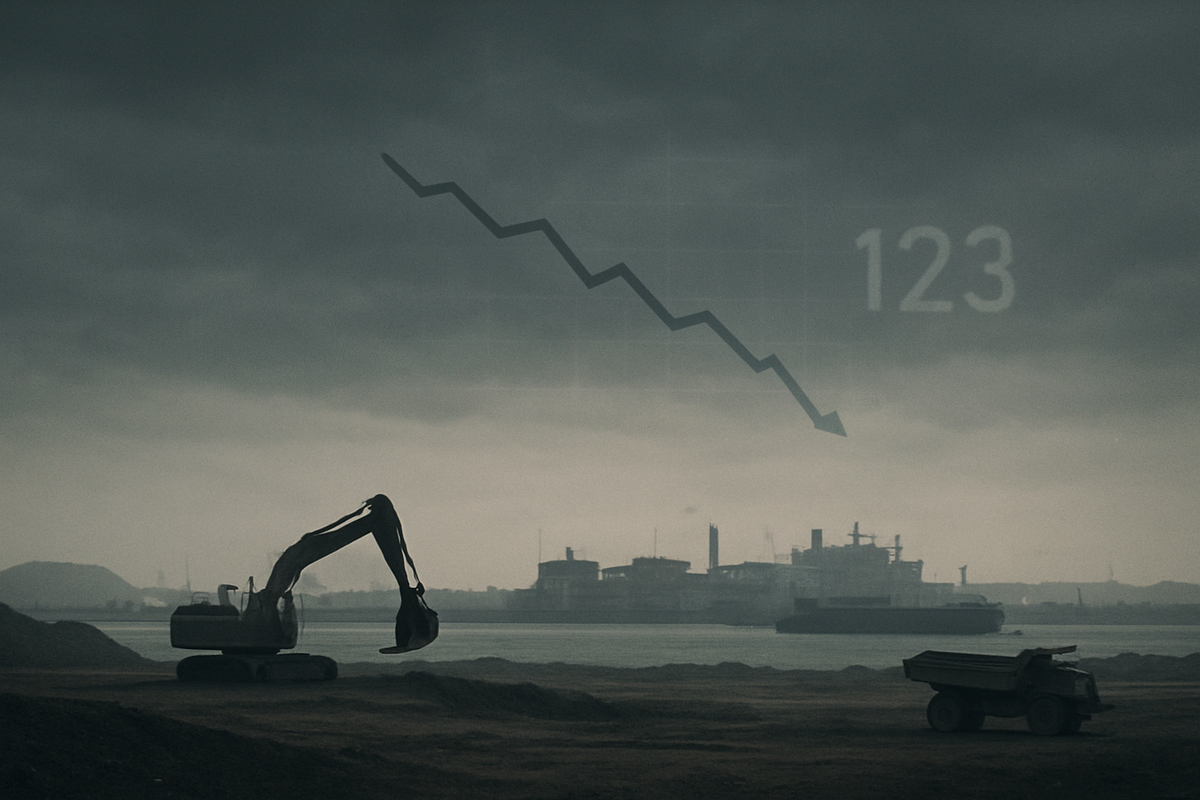
Shanghai, November 10, 2025 – The global iron ore market is experiencing a significant downturn, with prices plummeting to multi-month lows in November 2025. This sharp decline is predominantly driven by persistent and pervasive weakness in demand from China, the world's largest consumer of the steelmaking raw material. Benchmark contracts on both the Dalian Commodity Exchange (DCE) and the Singapore Exchange (SGX) have registered their lowest levels since July and September, respectively, signalling a challenging environment for the industry and sending ripples across global financial markets.
This slump underscores a critical juncture for the commodity sector, as the economic rebalancing in China, coupled with an oversupplied market, creates immediate and far-reaching implications. Major mining companies face significant pressure on their revenues and profitability, while steel producers grapple with squeezed margins and a cautious outlook. The situation suggests a deeper, structural shift in China's economy that could have long-term consequences for global commodity markets.
A Deep Dive into the Iron Ore Market's November Plunge
The most notable indicator of the price drop occurred on November 10, 2025, when both the Dalian Commodity Exchange (DCE) and Singapore Exchange (SGX) saw iron ore futures reach significant lows. The January contract for iron ore on China's DCE touched an intraday low of 756 yuan per metric ton ($106.23 USD), marking its weakest price point since July 10, 2025. Simultaneously, the benchmark December iron ore contract on the SGX fell to $100.85 per ton, a level not seen since September 1, 2025. This downturn was fueled by surging inventories at major Chinese ports, which reached 138.44 million tons by November 7, the highest level since March 21, indicating a significant disconnect between supply chain adjustments and actual consumption.
The persistent weakness in China's demand is the primary catalyst. The nation's property sector, historically a colossal consumer of steel, continues to struggle with reduced investment and new project starts, accounting for approximately 40% of China's total steel demand. This structural challenge is compounded by slowing factory activity and a contracting manufacturing sector, leading to widespread steel mill production cuts. Despite the lifting of environmental production restrictions in key steel hubs like Tangshan since November 9, the underlying insufficient demand for steel products remains a larger concern, preventing any significant market rebound.
The timeline leading to this multi-month low reveals a sustained downward trajectory. Iron ore prices had previously hit a low on July 10, with an unexpected downturn in China's factory activity for July further clouding the demand outlook. While August saw slight gains, oversupply concerns and forecasts of weak demand for 2025 persisted. By October, futures fell as investors focused on growing ore supply and seasonally slowing steel demand, pushing many Chinese steel mills into negative margins. The impending first ore shipments from the massive Simandou mine in Guinea by the end of November, set to significantly increase global supply, also cast a long shadow over future prices.
Key players and stakeholders include major global iron ore producers like Rio Tinto (ASX: RIO, LON: RIO), BHP Group (ASX: BHP), Vale SA (NYSE: VALE), and Fortescue Metals Group (ASX: FMG), who are directly impacted by price volatility. Chinese steel mills, the primary consumers, along with the Chinese government's policy decisions on steel production and economic stimulus, play crucial roles. Commodity exchanges such as the DCE and SGX provide the platforms for price discovery, while market analysts offer critical forecasts that shape investor sentiment. Initial market reactions were characterized by sharp declines in futures contracts, with any minor recoveries quickly tempered by overriding demand concerns and wider production cuts.
Corporate Fortunes: Winners and Losers in a Softening Market
The current downturn in iron ore prices creates a clear dichotomy of winners and losers among public companies, primarily impacting the mining and steel production sectors. Major iron ore mining companies are squarely in the 'loser' category, facing direct exposure to falling prices that erode their revenues and profitability.
Major Iron Ore Mining Companies:
- Rio Tinto (ASX: RIO, LON: RIO), as one of the world's largest iron ore miners, is heavily impacted. Lower prices and reduced demand from China could lead to scaled-back production and delayed expansion projects. The company has already reported decreased underlying profits and reduced interim dividends, with its dominant iron ore segment's struggles negatively affecting overall stock performance.
- BHP Group (ASX: BHP), despite its exceptionally low production costs, faces substantial headwinds. The company reported a 26% decline in underlying attributable profit for the 2025 financial year, largely due to a 19% decrease in average realized iron ore prices. Its free cash flow and dividends have also been impacted, leading to negative stock performance.
- Vale SA (NYSE: VALE), the Brazilian giant, is particularly vulnerable, with iron ore accounting for approximately 80% of its revenue. Its shares have plunged to their lowest levels since 2020, wiping out billions in market value, as investors remain concerned about China's economic challenges and fluctuating iron ore prices.
- Fortescue Metals Group (ASX: FMG), highly reliant on iron ore, is particularly sensitive. If prices fall below a critical threshold, its earnings could see a significant drop, making its stock highly susceptible to price declines.
Smaller, high-cost iron ore producers globally face the greatest risk, with potential operational shutdowns if prices remain depressed.
Steel Producers: Steel producers generally stand to benefit from lower iron ore prices, as it reduces their primary raw material costs, potentially improving profit margins. However, weak demand for finished steel, particularly from China's property sector, can temper these benefits.
- ArcelorMittal (NYSE: MT), as an integrated steel and mining company, experiences a mixed impact. While its mining segment feels the pinch, its steelmaking operations benefit from reduced raw material costs. However, weak steel demand in Europe and Brazil has led to lower shipments and production cuts, impacting overall profitability despite increased iron ore production from its own mines.
- Nippon Steel Corp. (TYO: 5401), Japan's largest steelmaker, could see reduced input costs from lower iron ore prices. However, the company faces significant challenges in the US steel market (following its acquisition of US Steel) and other market pressures that have led to drastic net profit declines.
- Indian Steelmakers (e.g., Tata Steel Ltd., JSW Steel Ltd., Steel Authority of India Ltd., Vedanta Ltd., Jindal Steel and Power Ltd.) are poised to benefit from lower iron ore prices, which directly reduce their input costs and enhance global competitiveness, especially for those not fully integrated with their own mines.
The overall impact sees miners struggling with reduced profitability and potential project delays, while steelmakers experience a complex trade-off between lower input costs and persistent demand weakness, particularly in China.
Wider Significance: Structural Shifts and Global Ripples
The multi-month low in iron ore prices in November 2025 due to weak China demand is not merely a transient market fluctuation; it signifies a deeper, structural transformation within the global mining and steel industries. This event underscores China's ongoing economic rebalancing, moving away from its steel-intensive, investment-led growth model towards services and less resource-intensive sectors. The protracted downturn in China's property sector, a colossal consumer of steel, remains a critical indicator that the "feverish growth" of the past decade is unlikely to return.
This price slump aligns with several broader industry trends. Firstly, a persistent oversupply characterizes the market, with major producers maintaining robust output and new low-cost projects, such as Simandou in Guinea, poised to add significant volumes. Secondly, the global steel industry's increasing focus on decarbonization and "green steel" production, favoring Electric Arc Furnaces (EAFs) and Direct Reduced Iron (DRI) technologies, could shift demand towards higher-grade ores in the long term, but currently, overall demand remains challenged. Geopolitical tensions also continue to influence supply chain resilience, prompting companies to consider diversification, though China's dominance in iron ore imports creates inherent vulnerabilities.
The ripple effects extend across the global economy. Major mining companies, while benefiting from low production costs, will experience reduced margins, potentially impacting dividends and slowing the development of new projects. Smaller, high-cost producers face existential threats, with many likely forced to scale back or cease operations if prices remain depressed. Iron ore exporting economies like Australia and Brazil, heavily reliant on commodity revenues, will experience significant economic headwinds. For Australia, a $10 per tonne decline in iron ore price translates to roughly $6.5 billion in reduced annual export earnings, impacting state and federal budgets and potentially weakening the Australian dollar.
Regulatory and policy implications are also significant. The Chinese government may implement further stimulus measures to support its property sector or boost infrastructure, though their long-term effectiveness is debated. Continued efforts to reduce steel production capacity to meet environmental targets and manage oversupply are also likely. Trade policies, potentially influenced by renewed US-China tensions, could lead to tariffs on steel or other manufactured goods, further dampening global trade and indirectly affecting iron ore prices. Historically, this downturn shares similarities with the 2014-2015 supply-driven collapse and the 2021 price correction, both heavily influenced by Chinese demand and policy decisions. However, the current scenario is layered with more pronounced structural shifts in China's economy and intensified global decarbonization efforts, suggesting any recovery might differ from previous commodity supercycles.
The Path Ahead: Navigating a Transformed Market
The outlook for the iron ore market after its multi-month low in November 2025 points to a fundamentally transformed landscape, demanding strategic pivots and adaptive measures from all participants. In the short term (late 2025 - early 2026), persistent price pressure is expected, primarily due to continued weak demand from China, high port inventories, and seasonal slowdowns in the steel industry. A significant rebound is unlikely, as underlying demand improvement remains elusive, and analysts like First Futures warn of ongoing downside risks.
Looking further ahead (2026 and beyond), the long-term outlook is decidedly bearish. A structural oversupply is anticipated, with major producers continuing robust output and new projects like Simandou in Guinea adding substantial volumes. China's steel demand is projected to decline structurally, driven by its property sector slowdown and a broader economic transformation away from investment-heavy growth. Wood Mackenzie forecasts Chinese steel demand to decline by 5-7 million tons annually over the next decade, while institutions like Goldman Sachs and BMI project a gradual decline in prices, potentially averaging $78-$93 per tonne by the end of the decade.
Strategic adaptations are paramount for survival and prosperity. Iron ore producers must prioritize stringent cost discipline and explore portfolio diversification into critical minerals like copper and lithium, aligning with future demand trends in renewable energy and electric vehicles. There will be a greater focus on value-added products and adapting to evolving buyer preferences, such as the increasing demand for higher-grade ores for green steel production. Miners will also need to engage directly with China's centralized procurement entities, like CMRG, and consider yuan-denominated settlements to maintain market access.
Market opportunities, though fewer, do exist. The global push for decarbonization and sustainable steelmaking presents an opportunity for high-grade iron ore producers, as demand for cleaner inputs for EAF and DRI technologies is expected to rise. India and Southeast Asia are emerging as potential bright spots for long-term steel demand, driven by ambitious infrastructure development. However, these opportunities are dwarfed by significant challenges, including persistent weak Chinese demand, global oversupply, margin compression for steelmakers, geopolitical risks, and increasingly stringent environmental regulations. The overarching outcome points towards a prolonged bear market, requiring resilience, innovation, and strategic diversification from all participants.
Wrap-Up: A New Era for Iron Ore
The multi-month low in iron ore prices observed in November 2025 is a critical juncture, signaling a profound recalibration of the global commodity market. The confluence of persistently weak demand from China, driven by its property sector woes and economic rebalancing, coupled with burgeoning port inventories and steel mill production cuts, has created a challenging environment that is unlikely to dissipate quickly. This is not merely a cyclical dip but rather an indication of a structural shift, marking an end to the super-cycle of surging industrial activity and robust steel consumption that once characterized the Chinese growth story.
Moving forward, the market is poised for continued pressure. China's domestic steel consumption is expected to decline structurally, and the fundamental supply-demand equation points to an enduring imbalance as global production expansion outpaces consumption growth. While some short-term factors like declining global shipments might offer fleeting support, the robust inventory build-up in China largely offsets these. The era of easy profits for miners and consistent growth for steelmakers is transforming, demanding a new level of strategic foresight and operational efficiency.
The lasting impact of this downturn will be felt across the entire value chain. Major iron ore producers will be compelled to reassess their long-term strategies, emphasizing cost discipline, portfolio diversification into critical minerals, and a focus on value-added products tailored for a decarbonizing steel industry. Smaller, high-cost producers face significant consolidation pressures. Resource-dependent nations will need to brace for reduced export earnings and adjust their fiscal policies. This transformation also highlights the emergence of new growth centers, with India and Southeast Asia poised to become increasingly important for global steel demand in the coming decades, backed by their own infrastructure development and manufacturing expansion.
Investors in the iron ore and steel sectors must remain vigilant in the coming months. Key indicators to watch include any significant Chinese government policy interventions or economic stimulus measures, though their long-term effectiveness remains uncertain. Closely monitoring steel mill profitability and production levels, along with iron ore inventory levels at Chinese ports, will provide crucial insights into demand fundamentals. Furthermore, tracking global steel demand trends in emerging economies and observing new supply developments, particularly from projects like Simandou, will be essential. The evolution of trade tensions and protectionist measures against steel exports will also influence market dynamics. The iron ore market is navigating complex structural changes, making vigilance and adaptability paramount for investors in the months ahead.
This content is intended for informational purposes only and is not financial advice





